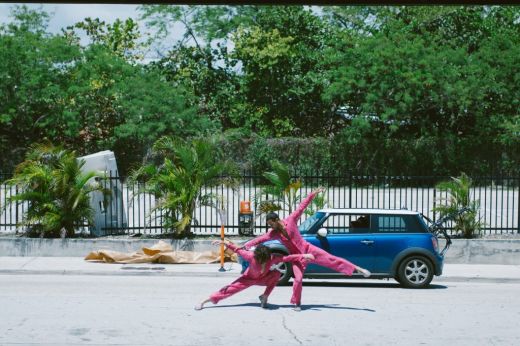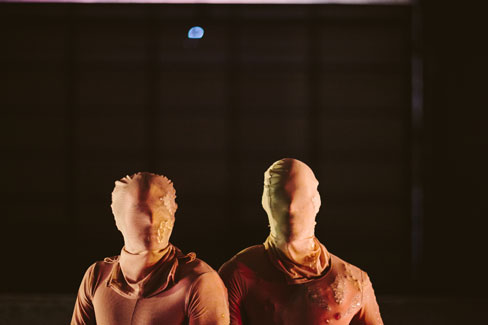
Performance view of TASTE. NW 11th Street, April 6th, 2013. Photo by Gesi Schilling.
There is a particular guttural feeling that develops when you recognize the importance of one thing against another—a silver moon against a starless sky, its brightness recognizable only by the surrounding darkness. It’s the feeling you have when one arbitrary color suddenly renders another arbitrary color magnificent; an acidic, engineered pink against a lush tropical green. TASTE is born out of these dichotomies. The bare skin of a dancer’s foot meets the gray, dusty concrete of a warehouse, traces of darkness are left on the pressure points: the pads, the large toe, the heel—each highlighted in a multitude of colors. As written in the New York Times obituary of Lily Pulitzer: an “embrace of jarring color combinations like flamingo pink and apple green….” Pulitzer, like this performance, existed at the intersection of high and low; examining and embracing camp, specifically when it was drawn out in the company of high culture.

Rashaun Mitchell and Silas Riener.
There were questionable moments, such as the poet’s condescending gaze as she poured champagne over the dancers, or her costume choice—black jeans, a black blouse; and leather, rubber soled-boots—which she reminded us was not her idea. Most provocations are rendered most eloquently when left unsaid, in poetry this can be a difficult task. Regardless, we were won over once the large garage door opened, and the frame through which this experience would be viewed became razor sharp; asphalt, the freeway, vehicular traffic, vagrants, and a black Mercedes driven by the masked Davison Scandrett… sincere, sweat-soaked gestures aching for recognition, not despite of, or against the backdrop. Rather, they are as synchronized with what natives call “this place” as a blue heron in a marshy swamp. By this point it was understood that this was a site-specific work, not just in terms of the performance space but in terms of the artists’ relationship to the city. They come here, but how often? Under which circumstances? Cultural tourism is often described in terms of an audience approaching culture, not from the perspective of artist as imposition. I couldn’t help leave this piece without visions of a 19th century milliner leaving an early Miami, not far from the site of this performance, with a bag full of exotic plumes, headed for an aesthetic black market with his newly gathered loot in tow.










